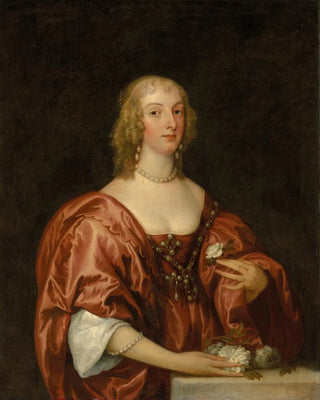Art print | Portrait of Anna Sophia, Countess of Carnarvon - School of Antoine van Dyck


View from behind

Frame (optional)
Portrait art print of Anna Sophia, Countess of Carnarvon - School of Antoine van Dyck – Captivating introduction
The "Portrait of Anna Sophia, Countess of Carnarvon," an iconic work from the School of Antoine van Dyck, embodies the elegance and refinement of the 17th century. This striking depiction of a noble woman, both majestic and intimate, transports the viewer into a universe where beauty and power intersect. The delicacy of her features and the richness of the colors evoke an era when art was not only a means of expression but also a symbol of social status. Through this portrait, van Dyck succeeds in immortalizing the very essence of his model, revealing the complexity and depth of her character.
Style and uniqueness of the work
Van Dyck's style is distinguished by his unique approach to portraiture, blending realism and idealization. In this piece, every detail is meticulously crafted, from the sumptuous drapery of the countess's gown to the luminous reflections of her jewelry. The composition is carefully balanced, highlighting the aristocratic figure of Anna Sophia while incorporating decorative elements that enrich the overall scene. The play of light, typical of Baroque art, creates an almost tangible atmosphere, where the viewer can feel the living presence of the model. The color palette, both soft and vibrant, enhances the emotional dimension of the portrait, making this work a true masterpiece.
The artist and his influence
Antoine van Dyck, one of the greatest portraitists of his time, left a lasting mark on art history with his ability to capture the soul of his subjects. A pupil of Rubens, he developed a style that is uniquely his own, characterized by exceptional finesse and meticulous attention to detail. His influence extends far beyond his era, inspiring many artists across the centuries. Van Dyck established a new standard in aristocratic portraiture, transforming the way nobles were depicted. By painting iconic figures such as the Countess of Carnarvon, he not only immortalized influential personalities but also contributed to the evolution of portraiture as an artistic genre.

Matte finish

View from behind

Frame (optional)
Portrait art print of Anna Sophia, Countess of Carnarvon - School of Antoine van Dyck – Captivating introduction
The "Portrait of Anna Sophia, Countess of Carnarvon," an iconic work from the School of Antoine van Dyck, embodies the elegance and refinement of the 17th century. This striking depiction of a noble woman, both majestic and intimate, transports the viewer into a universe where beauty and power intersect. The delicacy of her features and the richness of the colors evoke an era when art was not only a means of expression but also a symbol of social status. Through this portrait, van Dyck succeeds in immortalizing the very essence of his model, revealing the complexity and depth of her character.
Style and uniqueness of the work
Van Dyck's style is distinguished by his unique approach to portraiture, blending realism and idealization. In this piece, every detail is meticulously crafted, from the sumptuous drapery of the countess's gown to the luminous reflections of her jewelry. The composition is carefully balanced, highlighting the aristocratic figure of Anna Sophia while incorporating decorative elements that enrich the overall scene. The play of light, typical of Baroque art, creates an almost tangible atmosphere, where the viewer can feel the living presence of the model. The color palette, both soft and vibrant, enhances the emotional dimension of the portrait, making this work a true masterpiece.
The artist and his influence
Antoine van Dyck, one of the greatest portraitists of his time, left a lasting mark on art history with his ability to capture the soul of his subjects. A pupil of Rubens, he developed a style that is uniquely his own, characterized by exceptional finesse and meticulous attention to detail. His influence extends far beyond his era, inspiring many artists across the centuries. Van Dyck established a new standard in aristocratic portraiture, transforming the way nobles were depicted. By painting iconic figures such as the Countess of Carnarvon, he not only immortalized influential personalities but also contributed to the evolution of portraiture as an artistic genre.






